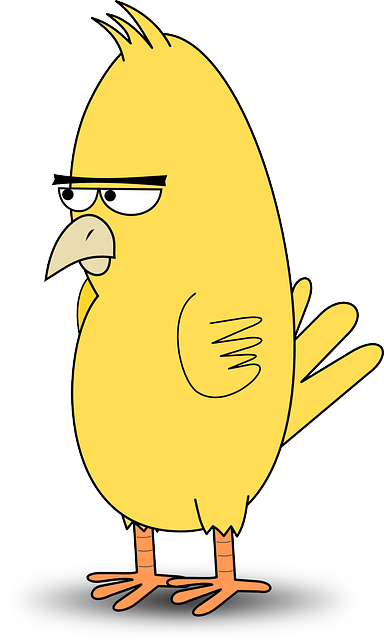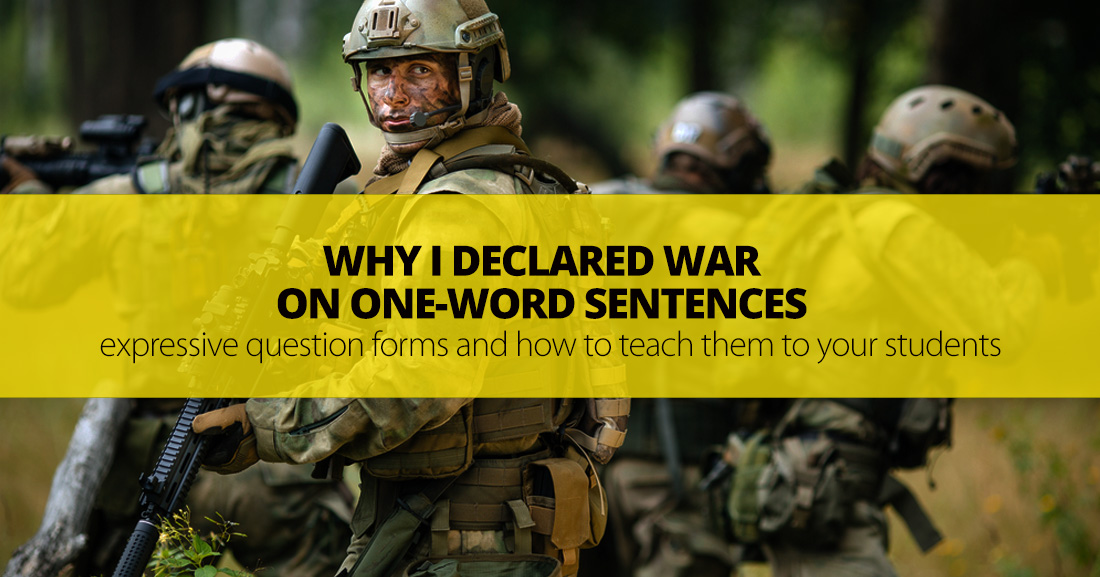
I try my best to be hip and up-to-date.
I really do. I’ve been paying attention to the teenage lingo, and I’m not completely lost when around it. I encourage my students to copy what they hear, and to try to sound native; this often means adopting slang and other idiomatic forms, and I’m fine with that, truly.
One exception to this pattern, as I’ve written about before is my dislike of ‘like’. I take steps to eradicate it whenever I hear it. My students are split on this; some agree that it makes them sound like a vacuous teenager, while others regard it as an essential element of the linguistic Zeitgeist. Debate can be spirited, and that’s as it should be.
And I have to say that another exception to my generally permissive attitude is that short-hand, irritatingly brief interrogative expression, ‘What?’
And before you roll your eyes at the prospect of another TeflGuy monologue on just how terrible the modern world has become, bear with me for a paragraph or two while I set out my stall. I suspect we’ll find a good deal of common ground.
4 Ideas for Teaching Your ESL Students Expressive Question Forms
-
1
What’s Wrong With ‘What?’

- It’s lazy. I’m committed to promoting fluency among my students, and therefore long ago declared war on one-word sentences. I mean, if a student uses one, it’s not as though they’ve drowned a puppy or started a fire in a rainforest; I just want them to remember that the English language is so wonderfully nuanced, enabling them to say precisely what you mean, and they’ve rejected this opportunity in favor of a single, very blunt, monosyllabic word.
- It doesn’t really communicate anything. Well, that’s not strictly true. It’s a very basic interrogative marker, expressing simply that you need your partner to repeat what they’ve just said. But it doesn’t express why you need it repeated, or what was lacking about the initial statement (see below).
- It’s rude. Apart from their deleterious effect on the gaining of fluency, single-word sentences are poor etiquette. They show a disrespect for the speaker, and an unwillingness to be precise about the actual nature of your question. Just ask my grandparents, who would clip my ear whenever I said it. In many cultures, it’s just not done.
- It’s lazy. I’m committed to promoting fluency among my students, and therefore long ago declared war on one-word sentences. I mean, if a student uses one, it’s not as though they’ve drowned a puppy or started a fire in a rainforest; I just want them to remember that the English language is so wonderfully nuanced, enabling them to say precisely what you mean, and they’ve rejected this opportunity in favor of a single, very blunt, monosyllabic word.
-
2
Fair Enough. But Why Do Our Students Use It So Often?
This is by no means an exhaustive list, but it helps us to consider why ‘what?’ is so common.
- Genuine incomprehension. They heard the words, but something entirely clouded their meaning. Perhaps the sentence was too long to follow, or had a complex structure which obscured its meaning. Perhaps a critical word was, in fact, a new word for the listener, and this made the sentence’s meaning impossible to guess.
- Auditory problems. They didn’t hear all the words. Maybe the speaker mumbled, or spoke too quickly (a common problem, by the way, among new teachers). Maybe there was some background noise which made it hard to hear.
- Surprise. We can generally (though not always) tell by the tone of the remark that the listener is taken aback by what they’re being told.
- Disbelief / Doubt. The listener can’t believe what they’re hearing. Again, the tone and facial expression will clue us in, but not necessarily on every occasion.
- Gaps in understanding. The sentence made partial sense, but gaps remain, either because of vocabulary problems, or because the listener lacks background information with which to make sense of the comment.
Let me give you a couple of examples of situations where it might be impossible to know which of these purposes the question has:
Example 1
Jerry: Did you see The Martian? Pete: Yeah, I loved it. My favorite actor was Chiwetel Ejiofor Jerry: What? Did Jerry not hear the name? Did he forget that Ejiofor was in this film? Or does he disbelieve that Jerry prefers Ejiofor over Matt Damon, or another actor?
Example 2
Sandra: The company’s downsizing soon. Paula: Oh no! What are they going to do. Sandra: They’re going to bring in efficiency experts from Eclareon Paula: What? Did Paula not hear the ‘efficiency experts’ part? Did she not understand (or recognize) the company name? Or perhaps she doesn’t believe their management could do such a thing?
We can’t know, because the question is too blunt. One word just isn’t enough.
- Genuine incomprehension. They heard the words, but something entirely clouded their meaning. Perhaps the sentence was too long to follow, or had a complex structure which obscured its meaning. Perhaps a critical word was, in fact, a new word for the listener, and this made the sentence’s meaning impossible to guess.
-
3
Alternatives and Solutions
In the same way that I try to ban ‘like’ as a method of stalling and approximation, and I’ve outlawed silence in my classroom, I’ve also tried to make ‘what?’ illegal. Instead, I encourage my students to say what they actually mean, and to try to describe the problem. Once they’ve let the speaker know what it is they haven’t understood, we can fix the problem quickly.
I raise awareness of this by:
- Writing the one-word question on a wall poster with a big red cross through it
- Frowning mirthlessly, at least initially, at people who say, ‘what?’
- Moving on from that to imposing forfeits on the transgressors. They have to sing, dance, or do something else embarrassing. These methods, though not ideal for every teacher or every class, can be remarkably effective.
- Using a circling hands, or expanding hands gesture to elicit more words than just that one
- Circling the question in red when it appears in written work, and requiring a correction from the student.
- Assigning error correction exercises so that my students can work together to compose better responses than ‘what?’
I also undertake something of an investigation into the students’ own languages, in order to discover whether there is a similar one-word interrogative expression, and if so, how it is seen and used. More often than not, it’s also seen as a bit blunt and direct, although there are notable exceptions, including Chinese and, to a lesser extent, Russian.
If the question crops up in listening exercises, or when we’re watching a TV show or a movie, I stop and ask the students to think of an alternative question.
Simply put, I follow the principle that, when it comes to language learning and production, more words are better than fewer, and moreover, precise language is better than vague language. We’ve got tremendously nuanced expressions for requesting more information and expressing our reaction to what’s been said, and I believe our students should learn to access these important resources.
- Writing the one-word question on a wall poster with a big red cross through it
-
4
So, What Should We Say, Instead of ‘What?’
Almost anything will do. Provided it’s not a one-word sentence, and conveys some sense of why you need the sentiment repeated, I’ll be happy. I teach any and all of the following phrases, among others:
Incomprehension
Could you say that again?
Which one did you mean?
I’m sorry, what does that word mean?
If you speak a little more slowly, I’ll understand you
I don’t recognize that name / expression / word
Is that the same as…
Is that the opposite of…
I’m sorry, you’ve lost me.
That’s a new word for me / I’ve never heard that before.
Hang on, did you mean to say that…Surprise
Where did you hear that?
Wow, I didn’t expect that.
Well, isn’t that something.
You’re going to have to run that past me again.Disbelief
Are you serious?
That’s unbelievable!
How can that be?
You’ve got to be kidding.
You’re pulling my leg, right?
I’m sure you can add to this list.
I suppose you could say that I just don’t care for one-word sentences, no matter why or how they happen.
I suppose you could say that I just don’t care for one-word sentences, no matter why or how they happen. I find them unpleasing and abrupt. Call me old-fashioned or pedantic, but there are more reasons than this for jettisoning ‘what?’ as a common expression in the ESL classroom. It reminds our students to be exact, to compose full sentences, and to express in detail what problem they’re having. It’ll help them sound engaged and polite and, you never know, it might just help nudge them a little further along the road to fluency.
P.S. If you enjoyed this article, please help spread it by clicking one of those sharing buttons below. And if you are interested in more, you should follow our Facebook page where we share more about creative, non-boring ways to teach English.








